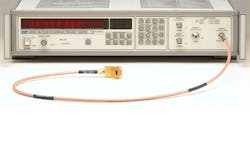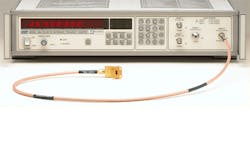Counting the Time for Testing Frequency
Frequency counters have long been one of the fundamental measurement tools for RF/microwave engineers. A few decades earlier, when frequency counters were often visible as stand-alone instruments in test-equipment racks, many instrument suppliers offered frequency counters as full-sized instruments with large-digit displays. The test-instrument industry is constantly changing, however, and large full-sized racks of test instruments have evolved into integrated solutions often with five or more measurement functions in the space where a single test function used to be.
One of those single test functions was the frequency counter, and it was traditionally joined by other essential single test functions, such as signal generation, power measurement, and spectrum analysis. Verifying the frequency of a continuous-wave (CW) or pulsed signal has long been important and will remain so with time, even as the measurement function is increasingly integrated in smaller test-equipment solutions.
One of the more ground-breaking companies in frequency-counter technology, EIP Microwave, has not exactly disappeared, but had its assets acquired by Phase Matrix, itself a part of National Instruments. An EIP Microwave frequency counter can still be found from time to time on the on-line sales site eBay, such as an EIP 545A for use from 10 Hz through 18 GHz in apparently good working order for only $300. But Phase Matrix also now sells an EIP line of frequency counters in half-rack and full-rack configurations, many available with power-measurement capability. The counters include models with optional measurement range as high as 170 GHz. They remain true to the innovative EIP architecture, which includes a YIG preselector filter for input signal noise reduction and more accurate frequency measurements.
Other companies once strong as suppliers of frequency counters, such as Fluke, have also gone through changes. Fluke, which was acquired by the Danaher Corp. in 1998, is probably best known for its digital multimeters (DMMs). But in its time, Fluke also offered accurate, full-sized RF/microwave frequency counters. Frequency counters, such as the dependable model 7015 frequency counter, are still available from long-time supplier Systron Donner, although this is another company that has gone through a great deal of change in recent decades.
For those who would prefer full-sized test equipment rather than modular instruments, such as in PXI or VXI formats, used frequency counters are regularly available at used-test-equipment sites such as Kandel Electronics, which offers everything from AC power supplies and amplifiers to oscilloscopes. Frequency counters such as EIP’s 18-GHz model 545A and frequency counters from Fluke are still available in good working order on used-product websites. (To more closely examine the wisdom of specifying used test equipment, a future blog will examine some of the used-test-Equipment sites such as Kandel and what it means to buy a “previously owned” piece of test gear.)
Modern frequency counters, such as the MCA3000 Series of instruments from Tektronix, tend to pack a number of different measurement functions into a single box. This is a microwave frequency counter and signal analyzer that includes a power meter. It is available in models operating to 27 and 40 GHz and is quite comprehensive in its frequency counting capabilities, measuring CW and pulsed signals. In fact, it can make “single-shot” measurements with 100-ps time resolution, and it bases its measurement accuracy on an internal 10-MHz oven-controlled crystal oscillator (OCXO) having signals available at a coaxial port for connection to other equipment. This instrument is very much representative of the modern frequency counter, rich in digital functions and containing many other measurement functions in a compact (half-rack) instrument housing.
A number of well-integrated frequency counters are available from major instrument suppliers, such as B&K Precision, Keysight Technologies, and Tektronix. For example, the models 53147A, 53148A, and 53149A from Keysight are half-rack instruments with handles that combine CW frequency counters, power meters, and DMMs. They feature upper frequency limits of 20.0 GHz, 26.5 GHz, and 46.0 GHz and serve as little test stations that can be brought to remote sites.
The MF2400C Series of microwave frequency counters from Anritsu Co. may be one of the exceptions to the modern rule of packing many different instrument functions into a single box. Although they can measure CW and pulsed signals, they are essentially “just” frequency counters in a half-rack instrument enclosure. With three models in the series starting at 10 Hz and extending to 20, 27, and 40 GHz, they can measure pulse widths as narrow as 100 ns with 1-ns resolution.
About the Author
Jack Browne Blog
Jack Browne, Technical Contributor, has worked in technical publishing for over 30 years. He managed the content and production of three technical journals while at the American Institute of Physics, including Medical Physics and the Journal of Vacuum Science & Technology. He has been a Publisher and Editor for Penton Media, started the firm’s Wireless Symposium & Exhibition trade show in 1993, and currently serves as Technical Contributor for that company's Microwaves & RF magazine. Browne, who holds a BS in Mathematics from City College of New York and BA degrees in English and Philosophy from Fordham University, is a member of the IEEE.

